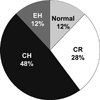Prevalence, clinical characteristics, and outcomes associated with eccentric versus concentric left ventricular hypertrophy in heart failure with preserved ejection fraction
- PMID: 23810323
- PMCID: PMC3788852
- DOI: 10.1016/j.amjcard.2013.05.061
Prevalence, clinical characteristics, and outcomes associated with eccentric versus concentric left ventricular hypertrophy in heart failure with preserved ejection fraction
Abstract
Although concentric remodeling (CR) and concentric hypertrophy (CH) are common forms of left ventricular (LV) remodeling in heart failure with preserved ejection fraction (HFpEF), eccentric hypertrophy (EH) can also occur in these patients. However, clinical characteristics and outcomes of EH have not been well described in HFpEF. We prospectively studied 402 patients with HFpEF, divided into 4 groups based on LV structure: normal geometry (no LV hypertrophy [LVH] and relative wall thickness [RWT] ≤0.42); CR (no LVH and RWT >0.42); CH (LVH and RWT >0.42); and EH (LVH and RWT ≤0.42). We compared clinical, laboratory, echocardiographic, invasive hemodynamic, and outcome data among groups. Of 402 patients, 48 (12%) had EH. Compared with CH, patients with EH had lower systolic blood pressure and less renal impairment despite similar rates of hypertension. After adjustment for covariates, EH was associated with reduced LV contractility compared with CH: lower LVEF (β coefficient = -3.2; 95% confidence interval [CI] -5.4 to -1.1%) and ratio of systolic blood pressure to end-systolic volume (β coefficient = -1.0; 95% CI -1.5 to -0.5 mm Hg/ml). EH was also associated with increased LV compliance compared with CH (LV end-diastolic volume at an idealized LV end-diastolic pressure of 20 mm Hg β coefficient = 14.2; 95% CI 9.4 to 19.1 ml). Despite these differences, EH and CH had similarly elevated cardiac filling pressures and equivalent adverse outcomes. In conclusion, the presence of EH denotes a distinct subset of HFpEF that is pathophysiologically similar to HF with reduced EF (HFrEF) and may benefit from HFrEF therapy.
Copyright © 2013 Elsevier Inc. All rights reserved.
Figures



Similar articles
-
Natural history of concentric left ventricular geometry in community-dwelling older adults without heart failure during seven years of follow-up.Am J Cardiol. 2011 Jan 15;107(2):321-4. doi: 10.1016/j.amjcard.2010.09.019. Epub 2010 Dec 2. Am J Cardiol. 2011. PMID: 21129719 Free PMC article.
-
Left ventricular geometry characteristics and clinical outcomes in hemodialysis patients with heart failure with preserved ejection fraction.BMC Cardiovasc Disord. 2024 Jun 27;24(1):327. doi: 10.1186/s12872-024-03985-x. BMC Cardiovasc Disord. 2024. PMID: 38926680 Free PMC article.
-
Associations of Left Ventricular Hypertrophy and Geometry with Adverse Outcomes in Patients with CKD and Hypertension.Clin J Am Soc Nephrol. 2016 Feb 5;11(2):271-9. doi: 10.2215/CJN.06980615. Epub 2015 Dec 14. Clin J Am Soc Nephrol. 2016. PMID: 26668021 Free PMC article.
-
Coronary microvascular dysfunction in hypertrophy and heart failure.Cardiovasc Res. 2020 Mar 1;116(4):806-816. doi: 10.1093/cvr/cvaa023. Cardiovasc Res. 2020. PMID: 31999329 Review.
-
Alterations in cardiac structure and function in hypertension.Curr Hypertens Rep. 2014 May;16(5):428. doi: 10.1007/s11906-014-0428-x. Curr Hypertens Rep. 2014. PMID: 24639061 Free PMC article. Review.
Cited by
-
Effects of Hypertrophic and Dilated Cardiac Geometric Remodeling on Ejection Fraction.Front Physiol. 2022 May 31;13:898775. doi: 10.3389/fphys.2022.898775. eCollection 2022. Front Physiol. 2022. PMID: 35711303 Free PMC article.
-
Tadalafil-induced improvement in left ventricular diastolic function in resistant hypertension.Eur J Clin Pharmacol. 2014 Feb;70(2):147-54. doi: 10.1007/s00228-013-1611-8. Epub 2013 Nov 24. Eur J Clin Pharmacol. 2014. PMID: 24271647 Clinical Trial.
-
The Association of Heart Failure and Liver T1 Mapping in Cardiac Magnetic Resonance Imaging.Diagnostics (Basel). 2025 Mar 20;15(6):779. doi: 10.3390/diagnostics15060779. Diagnostics (Basel). 2025. PMID: 40150121 Free PMC article.
-
Fructose plus High-Salt Diet in Early Life Results in Salt-Sensitive Cardiovascular Changes in Mature Male Sprague Dawley Rats.Nutrients. 2021 Sep 8;13(9):3129. doi: 10.3390/nu13093129. Nutrients. 2021. PMID: 34579006 Free PMC article.
-
Left ventricular geometry transition in hypertensive patients with heart failure with preserved ejection fraction.ESC Heart Fail. 2021 Aug;8(4):2784-2790. doi: 10.1002/ehf2.13349. Epub 2021 May 1. ESC Heart Fail. 2021. PMID: 33931949 Free PMC article.
References
-
- Komajda M, Carson PE, Hetzel S, McKelvie R, McMurray J, Ptaszynska A, Zile MR, Demets D, Massie BM. Factors associated with outcome in heart failure with preserved ejection fraction: findings from the Irbesartan in Heart Failure with Preserved Ejection Fraction Study (I-PRESERVE) Circ Heart Fail. 2011;4:27–35. - PubMed
-
- Zile MR, Baicu CF, Gaasch WH. Diastolic heart failure--abnormalities in active relaxation and passive stiffness of the left ventricle. N Engl J Med. 2004;350:1953–1959. - PubMed
-
- Maurer MS, King DL, El-Khoury Rumbarger L, Packer M, Burkhoff D. Left heart failure with a normal ejection fraction: identification of different pathophysiologic mechanisms. J Card Fail. 2005;11:177–187. - PubMed
-
- Shah AM, Pfeffer MA. The many faces of heart failure with preserved ejection fraction. Nat Rev Cardiol. 2012;9:555–556. - PubMed
-
- Maurer MS, Burkhoff D, Fried LP, Gottdiener J, King DL, Kitzman DW. Ventricular structure and function in hypertensive participants with heart failure and a normal ejection fraction: the Cardiovascular Health Study. J Am Coll Cardiol. 2007;49:972–981. - PubMed
Publication types
MeSH terms
Grants and funding
LinkOut - more resources
Full Text Sources
Other Literature Sources
Medical
Research Materials
Miscellaneous

